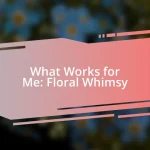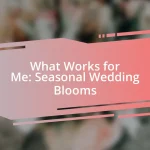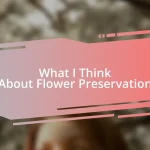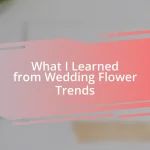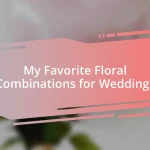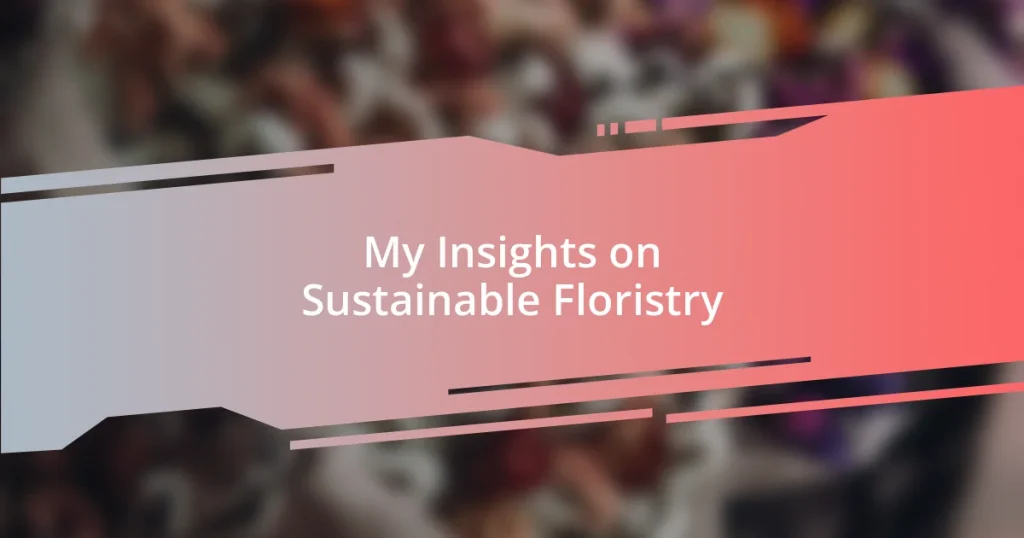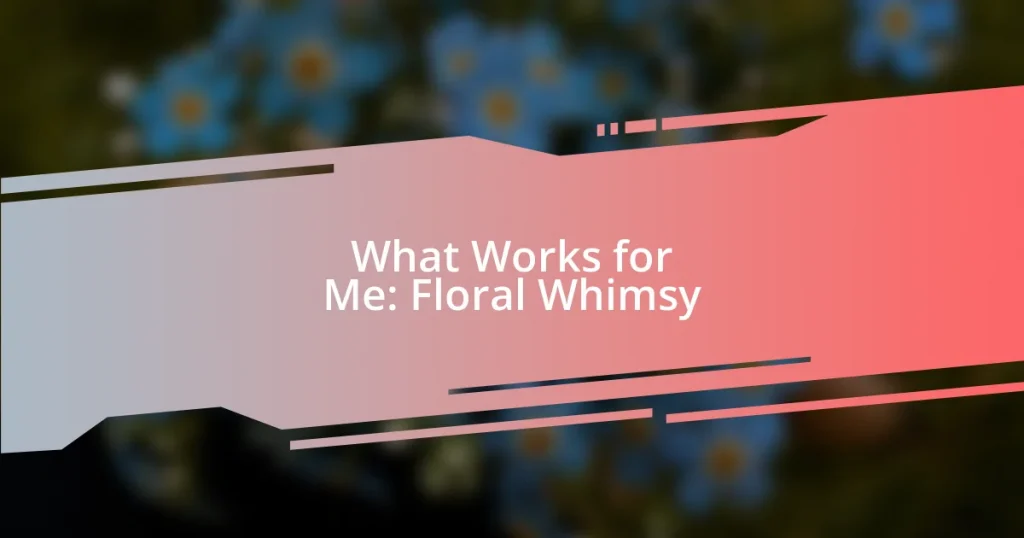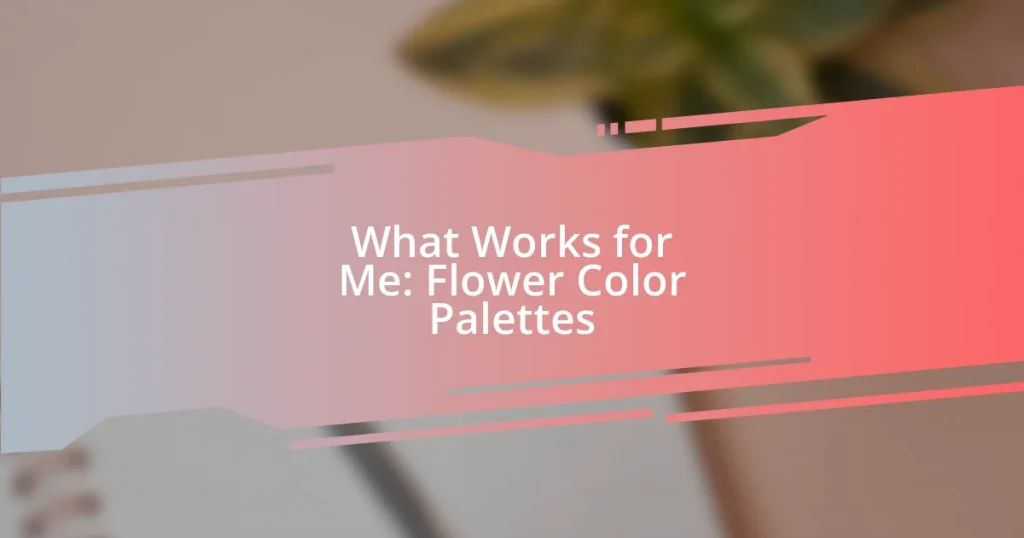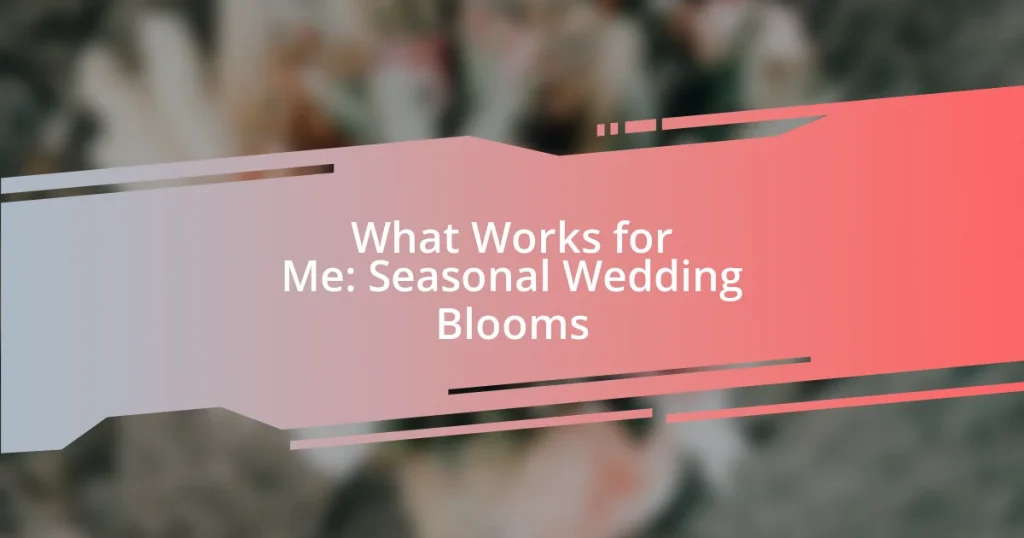Key takeaways:
- Sustainable floristry emphasizes local sourcing, seasonal flowers, and waste reduction, fostering community connections and minimizing environmental impact.
- Innovative practices, such as using biodegradable materials and technology to connect with local growers, enhance both the creativity and sustainability of floral arrangements.
- Building a sustainable florist business involves ethical sourcing, eco-friendly packaging, and active engagement in community initiatives, creating a positive ripple effect in society.
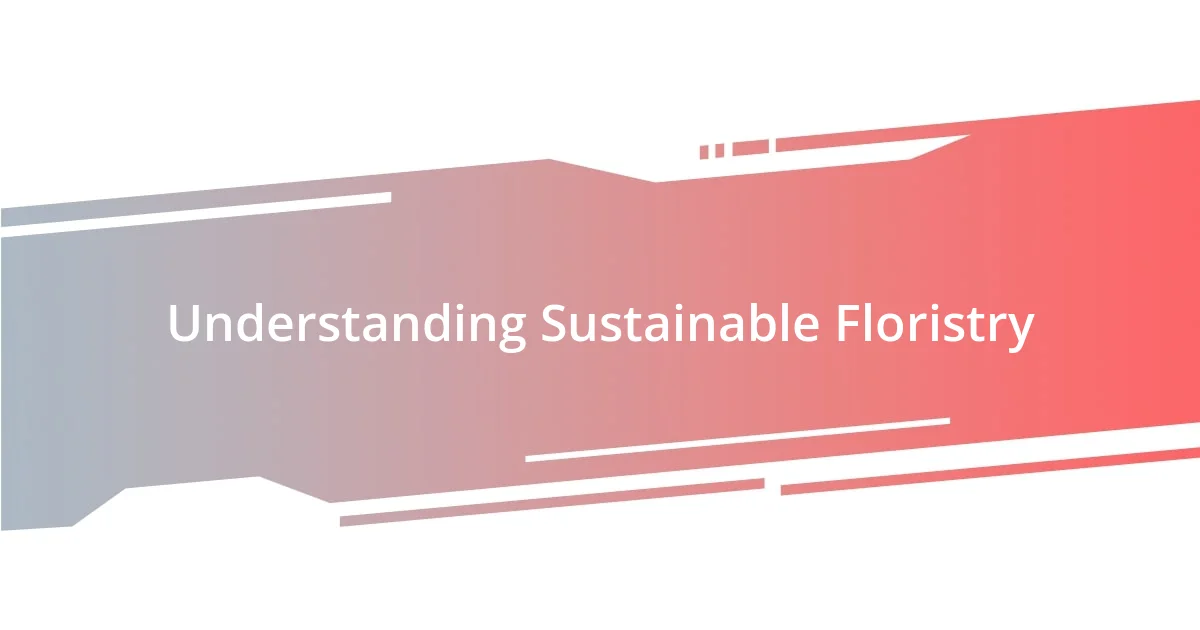
Understanding Sustainable Floristry
Sustainable floristry is about more than just pretty blooms; it embodies a mindful approach that respects our environment. I remember my first encounter with sustainable floristry; it was a workshop that opened my eyes to the impact of floral sourcing. Can you imagine the joy of creating arrangements that not only look beautiful but also contribute positively to our planet?
At its core, sustainable floristry emphasizes the use of locally sourced, seasonal flowers, reducing the carbon footprint associated with transportation. There’s something profoundly satisfying about supporting local farms, knowing your blooms are grown just around the corner. When I arranged my first bouquet with locally sourced flowers, I felt a connection not only to the earth but also to the community. Isn’t it refreshing to think of all the lives intertwined in that simple act of gifting flowers?
Moreover, sustainable floristry also tackles waste—recycling materials like vases, using compostable floral foam, or embracing biodegradable wrappers. I’ve transformed old glass jars into charming vases, which makes each arrangement feel personal and unique. Have you ever considered how our choices in floristry can ripple through the environment? By opting for sustainable methods, we can take a step towards a healthier planet, one flower at a time.
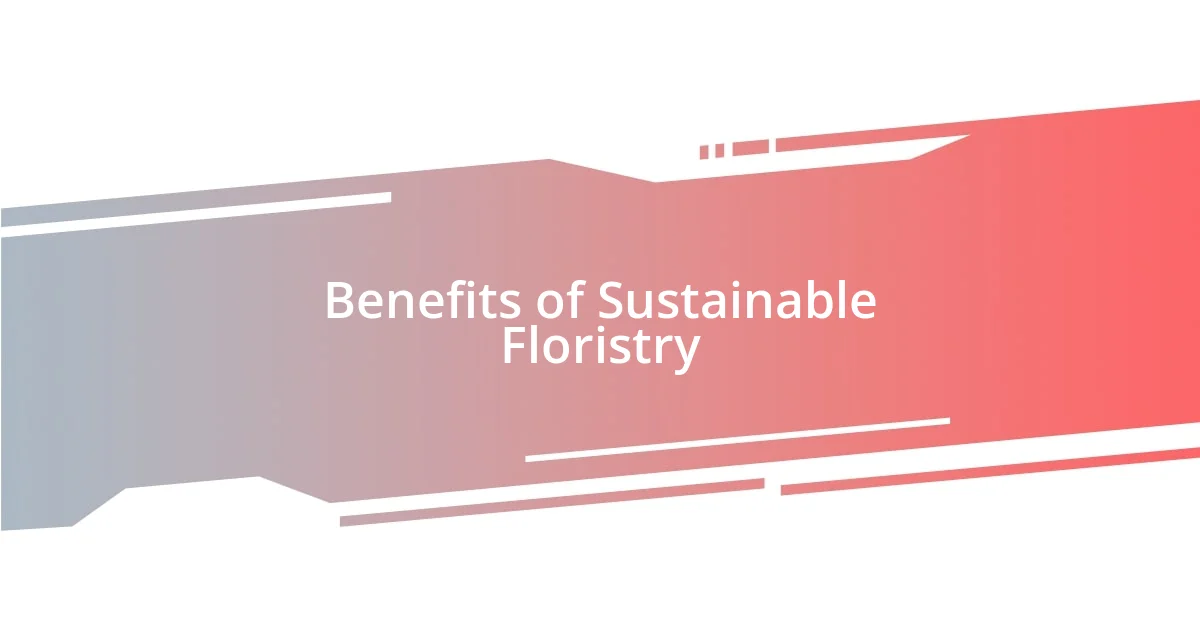
Benefits of Sustainable Floristry
One of the most profound benefits of sustainable floristry is its ability to promote biodiversity. Working with local, seasonal flowers not only nurtures the soil but also supports ecosystems in our communities. I recall visiting a small farm where the owner practiced permaculture. The vibrancy of the flowers and the buzz of bees were enchanting. It struck me how sustainability in floristry isn’t just about aesthetics; it’s about fostering an entire environment that flourishes.
- Supports local economies by partnering with nearby growers.
- Reduces transportation emissions, leading to a smaller carbon footprint.
- Enhances the beauty of local ecosystems through biodiversity.
- Encourages creativity and uniqueness in floral arrangements.
Another significant advantage is the reduction of waste in our floral practices. For instance, I’ve made it a habit to repurpose leftover stems and create simple, delightful arrangements that last longer. Something special blooms when we rethink our approach to waste—turning what might have been discarded into vibrant displays. It becomes a statement, showcasing our commitment to a sustainable future, while simultaneously giving us the chance to express ourselves creatively in a more responsible way.
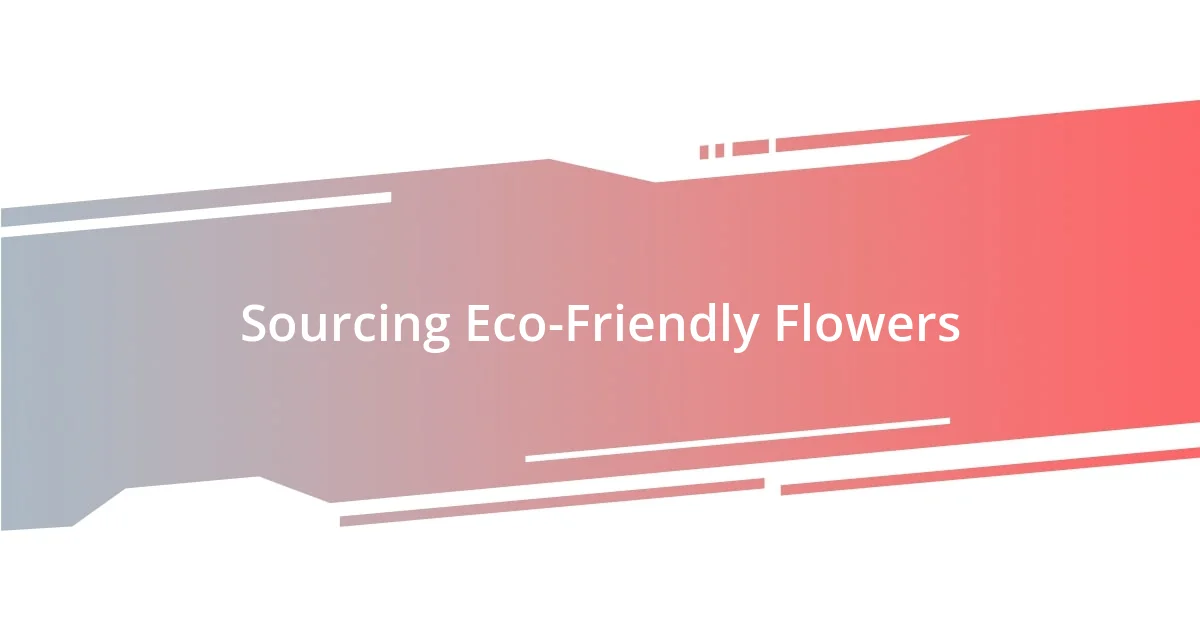
Sourcing Eco-Friendly Flowers
Sourcing eco-friendly flowers involves a conscious effort to choose blooms that benefit our planet rather than harm it. I vividly remember my first visit to a local organic flower farm, where I was amazed by the beauty of flowers thriving without harmful pesticides. The farmer shared stories about their sustainable practices, and it highlighted just how vital our sourcing choices are. This experience taught me that supporting organic growers not only results in healthier flowers but also helps protect our ecosystem. Have you ever wondered how the flowers we choose can influence not just our arrangements but also the earth?
Furthermore, exploring certified sustainable flower options, such as those marked with Rainforest Alliance or Fair Trade certifications, can greatly enhance our floral choices. These certifications ensure that flowers are cultivated while considering environmental impact and the welfare of workers involved. When I discovered Fair Trade flowers for my arrangements, I felt a deeper connection to the source. Knowing that my purchases contributed to fair practices made each bouquet feel even more meaningful. It resonated within me, emphasizing how simple choices can lead to significant positive impacts in the world of floristry.
To make more informed decisions about sourcing, it’s helpful to compare different flower sources based on various criteria such as environmental impact, labor practices, and local availability. Below is a table with insights that I find useful for differentiating these sources:
| Flower Source | Key Features |
|---|---|
| Local Growers | Seasonal blooms, low carbon footprint, supports local economies |
| Organic Farms | Pesticide-free cultivation, promotes biodiversity, healthier for consumers |
| Fair Trade Certified | Ethical labor practices, supports fair wages, responsible farming |
| Imported Flowers | Potentially high carbon footprint, possible use of pesticides, often less fresh |
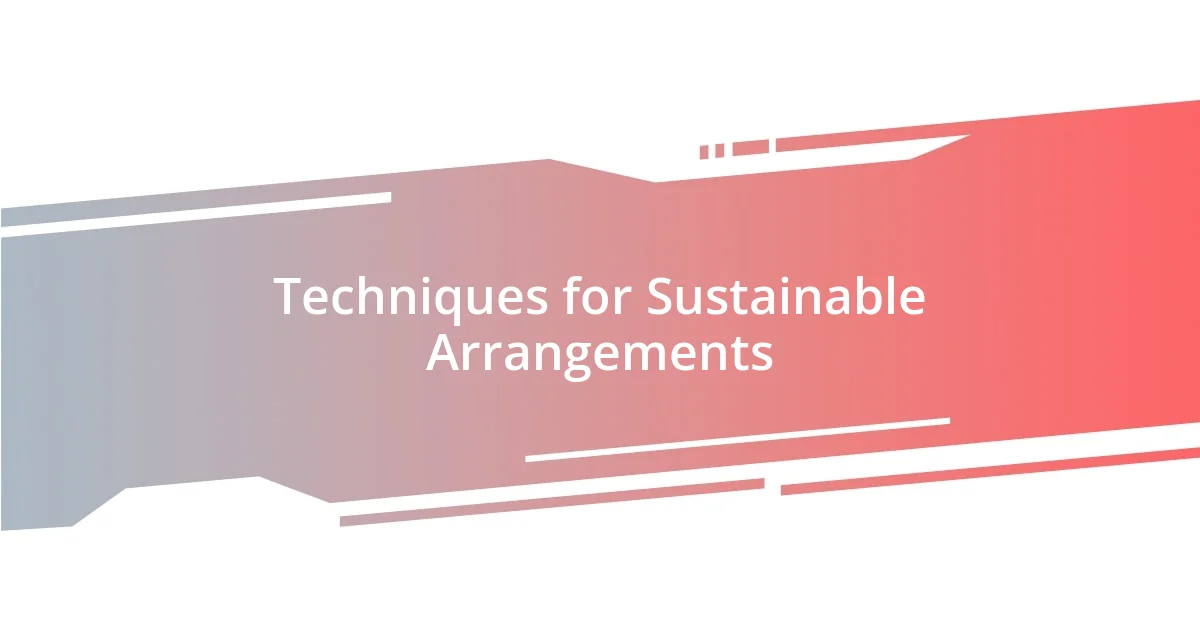
Techniques for Sustainable Arrangements
When it comes to arranging flowers sustainably, one technique that resonates with me is the use of natural materials instead of synthetic ones. I remember a workshop where we crafted floral arrangements using twigs, moss, and dried leaves. The earthy textures intensified the bouquets’ beauty and fostered a sense of connection to nature. Have you ever thought about how much charm these natural elements can bring to your floral designs while being kinder to the environment?
Another approach I find invaluable is experimenting with minimalism. I’ve created stunning arrangements with just a few blooms strategically placed within the design. It feels liberating to embrace the beauty of simplicity while reducing resource consumption. This technique encourages creativity by prompting you to focus on the flowers’ unique characteristics without overwhelming them. Who knew that less truly could be more?
Using locally sourced greenery for filler is another technique I often advocate for. In my floristry practice, I’ve found that incorporating local foliage not only enhances the aesthetic but also deepens the environmental integrity of the arrangement. I recall integrating a mix of ferns and branches from a nearby park into a wedding bouquet. The richness of the local landscape shone through, and the bride felt a personal connection to her surroundings. Isn’t it inspiring to think that the greenery we often overlook can play a significant role in creating sustainable beauty?
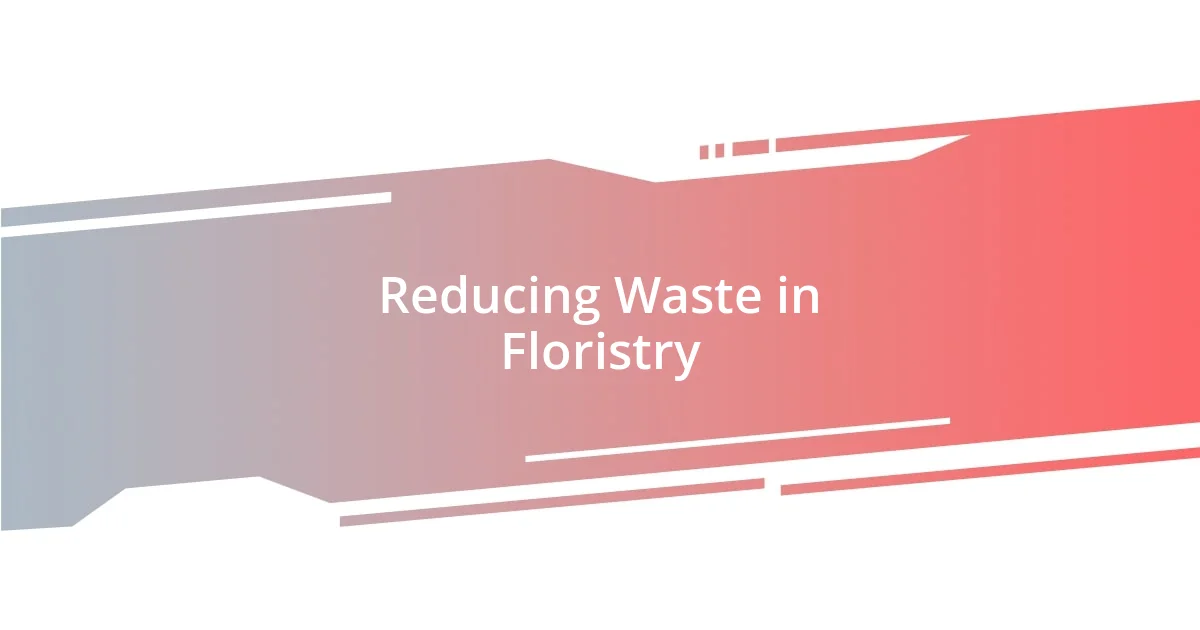
Reducing Waste in Floristry
Reducing waste in floristry is an eye-opening journey that I’ve embarked on through my experiences. I once attended a floral design event where the organizers encouraged us to bring our own vases instead of using the standard disposable ones. It was a small change, but seeing everyone’s unique vessels brought a sense of community and creativity that I never expected. Have you ever considered how a simple action like this can not only reduce waste but also tell a story through each arrangement?
I’ve found that repurposing flowers is one of the most rewarding practices in minimizing waste. For instance, after a big event, I often take home leftover blooms and rework them into smaller bouquets or centerpieces for friends. It’s amazing how a little creativity can breathe new life into what might otherwise be discarded. This practice not only lessens waste but also spreads joy when I surprise someone with a fresh bouquet. Have you thought about how you could repurpose flowers in your own life?
Another impactful strategy involves composting organic material from my floral work. I remember the first time I set up a compost bin at my home and started tossing in flower trimmings. It felt great to know that my waste was being transformed into nutrient-rich soil rather than ending up in a landfill. This experience solidified my belief that even in floristry, we can embrace a full-circle approach by giving back to the earth. Isn’t it fulfilling to think that our creative endeavors can contribute positively to the environment?
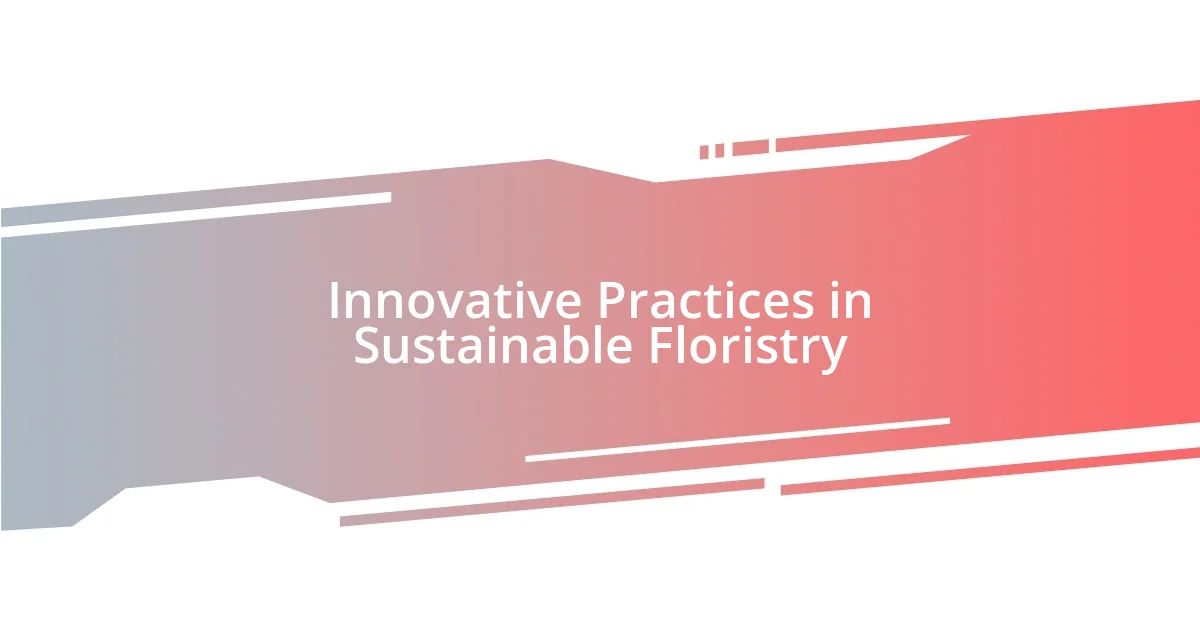
Innovative Practices in Sustainable Floristry
Exploring innovative practices in sustainable floristry has opened my eyes to the powerful impact of circular materials. Recently, I started using dried flowers and foliage in my arrangements that not only add a unique aesthetic but also minimize waste. The other day, I crafted a bouquet using a mix of dried lavender and eucalyptus from last season’s stock. It brought me such joy to see how vibrant and fresh these seemingly “old” blooms looked, reminding me that sustainability can also be about preserving memories while creating beauty.
Another exciting trend I’ve embraced is the shift towards eco-friendly floral foam alternatives. Traditionally, floral foam byproducts are not biodegradable, which tasked my conscience. When I stumbled upon biodegradable options, like coconut coir and flower frogs, my floral designs felt like a win-win. It really sparked my creativity—creating stunning arrangements without that weight of guilt over environmental harm. Doesn’t it feel liberating to know that you can achieve the desired structure without compromising on your values?
Lastly, I’ve seen a growing trend in the use of technology to promote sustainable practices. A florist friend of mine introduced me to an app that connects florists with local farmers to purchase flowers in season. This practice not only helps in reducing carbon footprints due to less transportation but also supports local economies. Using such tech-driven solutions in our craft truly excites me, showing that innovation in floristry can walk hand-in-hand with sustainability. Have you ever considered how technology might enhance your own sustainable practices in any creative field?
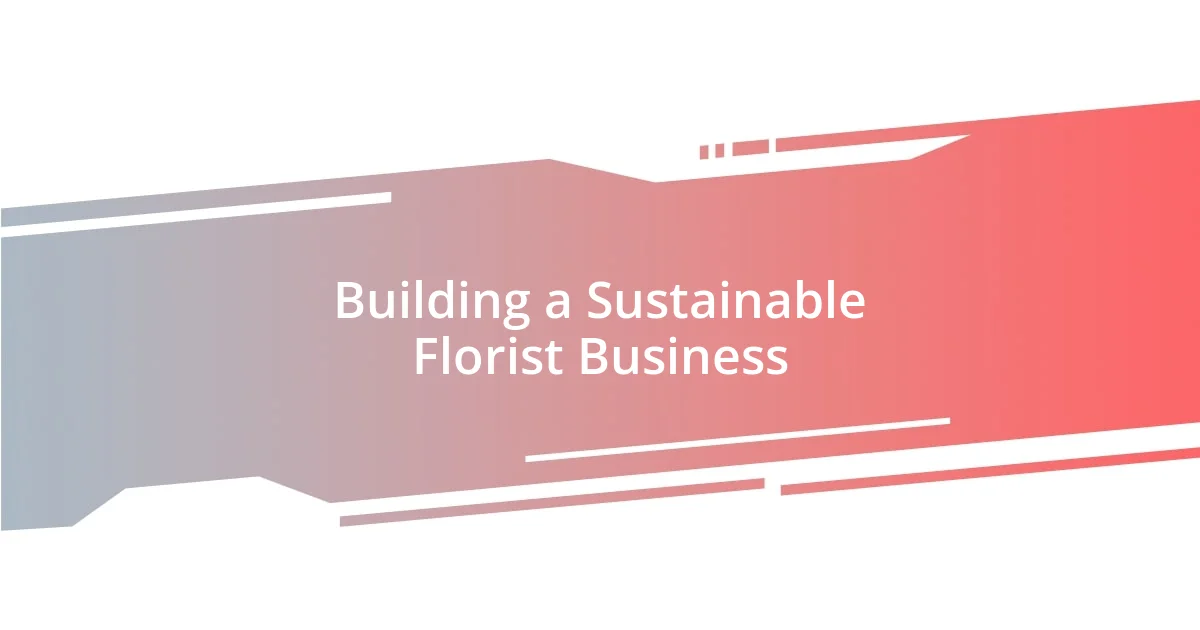
Building a Sustainable Florist Business
Building a sustainable florist business starts with sourcing ethically produced flowers. I remember the first time I sourced blooms directly from a local farm—there’s something incredibly satisfying about knowing the flowers are grown responsibly and the farmers are treated fairly. It felt like I was a part of something bigger, and it sparked a desire in me to keep exploring how my choices as a florist directly impact both the community and the environment. Have you ever considered how the source of your materials reflects your business values?
Another critical aspect of sustainability involves the packaging and materials we use. Transitioning to compostable or reusable packaging was a game-changer for my business. I once gifted a bouquet wrapped in beautifully crafted, recyclable paper that not only protected the flowers but also made the recipient feel cherished. Seeing the joy on their face reinforced my belief: packaging can elevate the gifting experience while still being kind to the planet. How often do you think about the message your packaging sends?
Finally, engaging in community initiatives has made my florist business not just a job but a meaningful part of my life. When I teamed up with local organizations for events that promote flower recycling and donations, I felt an overwhelming sense of connection. Last year, we donated unused flowers to a nearby shelter, which brightened up their space while supporting those in need. This experience illuminated how intertwined our social responsibilities are with our business practices. Isn’t it inspiring to think that your business can create a ripple effect of kindness in the community?
